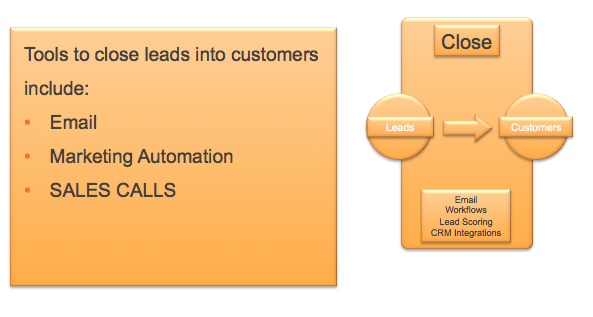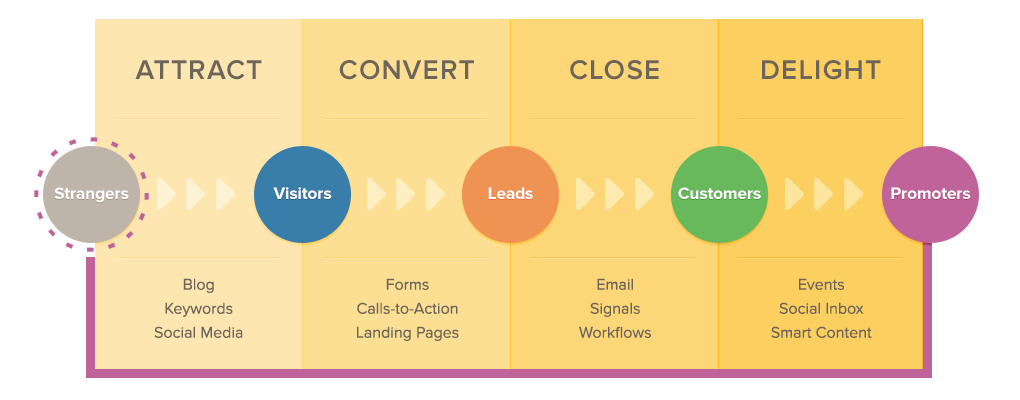Having written two blogs explaining why Inbound Marketing is the proven methodology for the digital age by attracting interested buyers in an “inbound” rather than an “outbound” way, I’d now like to zero in on Step #3 in the buyers journey: Close.
Of the four inbound marketing actions, “Close” lands your business an actual customer
To review, the HubSpot graph below illustrates the four parts of a successful inbound marketing strategy: 1) Attract, 2) Convert, 3) Close, and 4) Delight. Once you’ve attracted the right visitors and converted the right leads, you then need to transform those leads into customers.
How can you most effectively accomplish this feat? There are a number of marketing tools that can be used at this stage to make sure you’re closing the right leads at the right times.
“Closing” tools include:
- CRM: Keep track of the details about all the contacts, companies and deals in your pipeline so you can easily get in touch with the right prospects at the right time.

Customer Relationship Management (CRM) systems facilitate sales by making sure you have the right information at your fingertips to better engage with prospects across every channel. - Closed-Loop Reporting: How do you know which marketing efforts are bringing in the best leads? And is your sales team effectively closing those best leads into customers? Integration with your CRM system allows you to analyze just how well your marketing and sales teams are working together.
- Systematic Emails: You can still establish an ongoing relationship with a visitor who clicks on your call-to-action button, fills out a landing page or downloads your whitepaper but still isn’t ready to commit to becoming a customer. A series of emails to the prospect focused on useful, relevant content can build trust and help him/her become more ready to buy.
- Marketing Automation: This process involves creating email marketing and lead-nurturing tailored to the needs and lifecycle stage of each individual lead. For example, if a visitor downloaded a white paper on a certain topic from you in the past, you might want to send that lead a series of related emails to keep you and your business top-of-mind. And if they follow you on Twitter and consistently visit certain pages on your website, you might want to change the messaging to reflect those different interests.
So how do you seal the deal?
Even if you’re just starting out as an inbound marketer, it’s easy to read the signs when a lead has entered the “Close” stage. He/she may fill out a form to download a white paper, request a PowerPoint or register for a webinar — calls-to-action which you have offered that prospect by way of emails, social media and/or your website. This action on their part tells you they’re ready for some type of sale.
Keep in mind: You will close more decision stage leads by making sure your offer is useful and valuable to your prospect and is offered at the correct stage in their buyer’s journey.
The key to sales is understanding and capitalizing on what “searchers” want and need
As inbound marketing teaches us, the typical searcher starts out with a general idea of what he/she might be looking for, using search words to find an array of options. If your site provides intelligent information about your solutions and is optimized with keywords that best match what that consumer is searching for, hopefully that potential customer will click on your site to learn more. That’s when your work begins, turning that visitor into a lead, then a “closed” satisfied customer.
Yes inbound works, and how!
As Certified HubSpot Partners, we at Simon Associates have been watching the impact of inbound marketing on our own consulting business and those of our clients that have been using our inbound services, and the results have been truly astounding. What’s particularly valuable is the well-defined path that allows marketers to establish an ongoing relationship with consumers that is both highly effective and highly measurable.
To learn more about Inbound Marketing
I recently wrote a white paper explaining how to “do” Inbound Marketing where I covered:
- The data: How today’s consumers are shopping for solutions and answers to their questions
- The process: How marketing should change its processes to capture searchers
- The tools: How to initiate the Inbound Marketing journey for your business
This might be very helpful as you contemplate Inbound Marketing for growing your company. To download my white paper, click below.
Simon Associates is all about helping organizations grow, change and thrive
To talk with us about how Inbound Marketing could help your business grow, contact us at your convenience.




